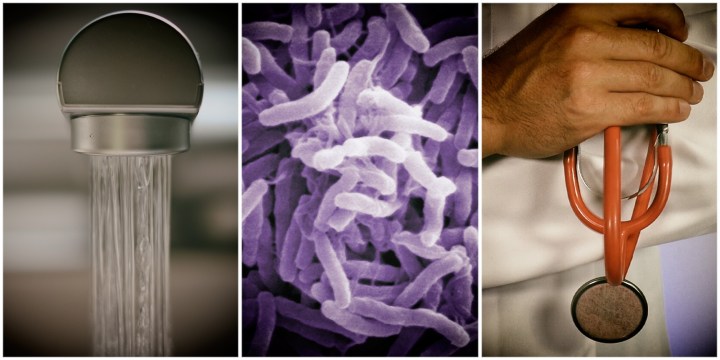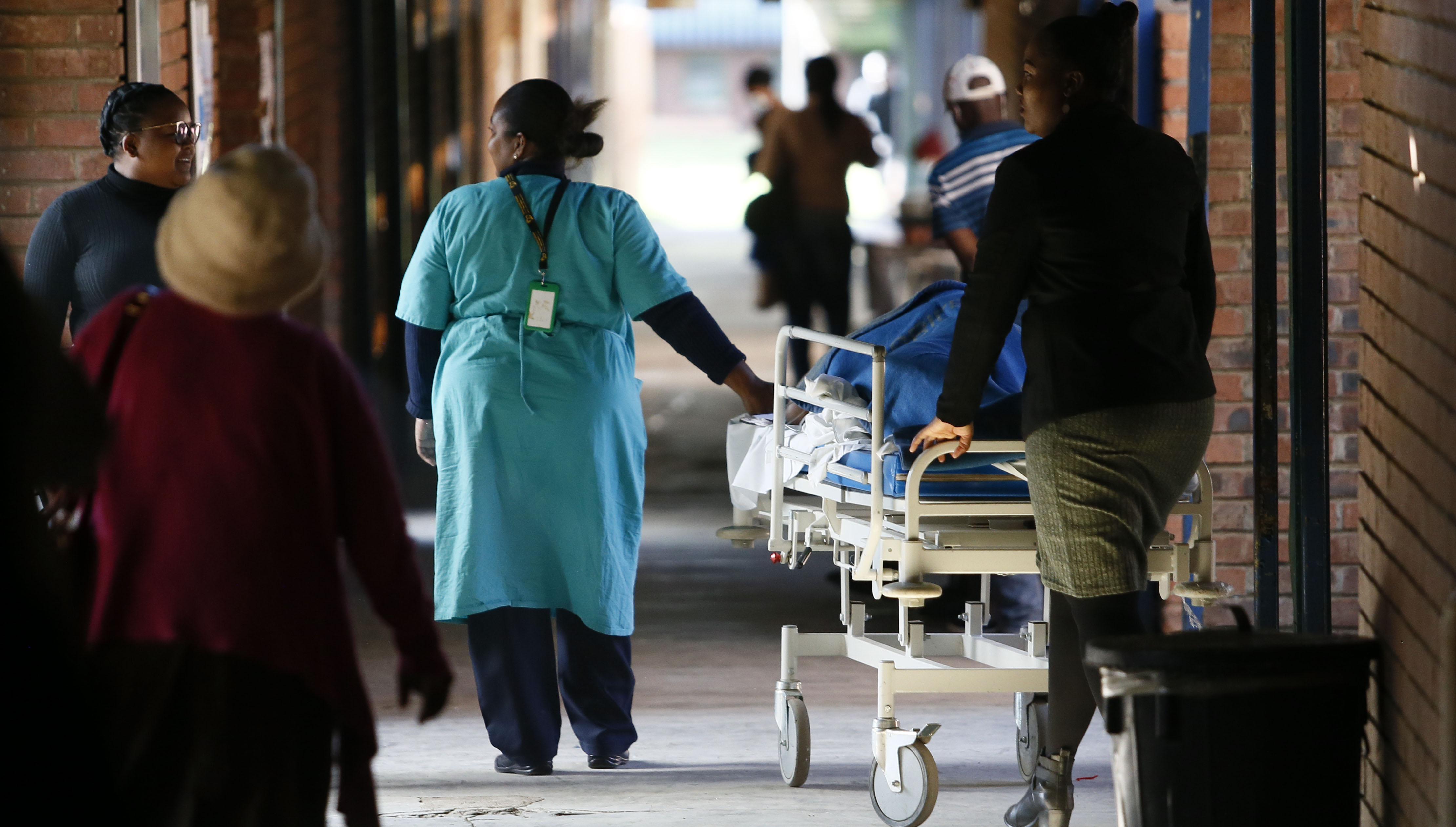EXPLAINER
Cholera outbreak in Gauteng – what you need to know about the disease, its spread and how to stay safe

The National Institute for Communicable Diseases is investigating the source of a ‘diarrhoeal disease’ outbreak in the City of Tshwane’s Region 2, which includes Hammanskraal. Below is an explainer on cholera, diphtheria, gastro and diarrhoeal disease, and mumps.
What is cholera?
Cholera is a diarrhoeal disease caused by a bacterium called Vibrio cholerae, according to the National Institute for Communicable Diseases (NICD). The bacterial disease is usually spread through contaminated water and can cause severe acute diarrhoea and dehydration. On Sunday, the Gauteng Department of Health confirmed a cholera outbreak in the rural town of Hammanskraal near Tshwane.
Signs and symptoms of cholera
It takes between 12 hours and five days for a person to show symptoms after ingesting contaminated food or water, according to the NICD.
Symptoms of cholera infection are not easily identified, but include acute watery diarrhoea, vomiting, a sudden onset of illness and dehydration.
How cholera is spread
Water contaminated with human faeces is the most common means of cholera transmission, either directly (through drinking contaminated water) or indirectly (through eating contaminated food). Water can be contaminated at its source or during storage.
Read more in Daily Maverick: Is a bigger cholera outbreak coming for Gauteng’s townships?
Food can become contaminated when it comes into contact with contaminated water. Vegetables that have been fertilised with human excreta (night soil) or “freshened” with contaminated water also become contaminated. Fish (particularly shellfish) sourced from contaminated water and eaten raw, or insufficiently cooked, may also cause infection.
Soiled hands can also contaminate clean drinking water and food.
What to do if someone is affected with cholera
The NICD states: “Antibiotics are recommended for patients with moderate or severe dehydration”, but usually patients are treated without having to be admitted to hospital.
Rehydration (replacement of lost body fluid) is the mainstay of treatment and is lifesaving. Mild cases of cholera can be managed outside of hospital with oral rehydration.
A homemade sugar-salt solution is a good way to keep a person hydrated. The World Health Organization recommends that homemade sugar-salt rehydration solutions contain eight level teaspoons of sugar and one level teaspoon of salt added to one litre of clean, boiled and then cooled water.
How to prevent the spread
In an outbreak, the best control measures are the early detection of cases and treatment of patients, coupled with health education, according to the NICD. Hand washing is vital for healthcare workers and the community.
Health facilities should have access to adequate quantities of essential supplies, particularly oral rehydration solution and intravenous fluids to respond quickly to a cholera outbreak and prevent deaths. Provision of potable (treated) water and improved sanitation, as well as health education, are necessary to prevent the spread of cholera in the community.
Cholera vaccines are also used in outbreak situations. The WHO recommends that these are used in vulnerable populations in areas under threat of cholera outbreaks, but should not be used routinely. In South Africa, Dukoral is available commercially.
Communities should also make use of safe water: “If people are concerned about the quality of water they use for drinking and cooking, it is recommended to treat the water first by boiling it (place water in a clean container and bring it to the boil for 1 minute) or treat it with household bleach. Add 1 teaspoon of household bleach – containing 3 to 5% chlorine concentration – to 20 litres of water, mix well and leave it to stand for at least 30 minutes before use,” according to the NICD. Water should be stored and covered in clean containers.
As contaminated food may also be a source of cholera infection, attention to food safety is essential to prevent faecal contamination by food handlers. Street vendors and communal food sources will require particular attention through health education, as they pose a special risk.
What is diphtheria?
Diphtheria is a contagious and potentially life-threatening bacterial infection. It is caused by infection with a toxin-producing strain of Corynebacterium diphtheriae or, more rarely, Corynebacterium ulcerans or Corynebacterium pseudotuberculosis, according to the NICD.
Bacterial infections occur in two forms – respiratory diphtheria, which affects the respiratory system, and cutaneous diphtheria, which affects the skin.
Two cases of diphtheria, one in the Western Cape and another in Gauteng, have been confirmed in South Africa since April.
Children who are not immunised or did not complete the Expanded Programme of Immunisation schedule, are at increased risk of getting diphtheria.
Adults may also be at risk of contracting diphtheria if the organism is present in the community, as adult immunity following vaccination wanes with time. Individuals living in crowded conditions are also at increased risk of getting the disease.
How is diphtheria transmitted?
Diphtheria spreads from person to person through contact with respiratory droplets or hand-to-mouth contact with secretions from an infected person’s mouth, nose, throat or skin.
Occasionally, individuals can carry the microorganism in their throat, but have no symptoms, and can also spread the organism through respiratory droplets. Less frequently, the infection can be transmitted through close contact with skin lesions in a person with the cutaneous form of the illness. Prolonged close contact is normally required to transmit the infection to others.
Diphtheria that is caused by C. ulcerans or C. pseudotuberculosis can also spread through contaminated milk or close contact with infected animals, through working on a farm or as a veterinarian.
Signs and symptoms
Symptoms of respiratory diphtheria usually start two to five days after exposure, although the incubation period can be longer, ranging from one to 10 days.
Initial signs and symptoms include fever, malaise, chills, loss of appetite, sore throat, nausea and vomiting. A whitish/greyish pseudomembrane may form over the throat and tonsils, making it hard to swallow and breathe. The “membrane” is necrotic tissue.
The infection can also cause the lymph glands and tissue on both sides of the neck to swell (bull neck). Complications of diphtheria include respiratory obstruction and myocarditis with cardiac arrest or cardiac failure.
The cutaneous form of diphtheria often presents as a non-healing ulcer with a dirty grey membrane.
What to do if someone is affected
Patients should be given diphtheria antitoxin to neutralise the diphtheria toxin, according to the NICD: “The decision to give diphtheria antitoxin is based on clinical diagnosis, and should not wait for laboratory confirmation.”
Antibiotics have not been demonstrated to affect the healing of local infections. However, they are used to eliminate C. diphtheriae from the nasopharynx and prevent its spread to others.
How to prevent diphtheria
Diphtheria is prevented by immunisation with a diphtheria-containing vaccine. In South Africa, the Expanded Programme on Immunisation (SA-EPI) schedule includes six doses of diphtheria vaccine. The primary series of vaccination is given in three doses at six, 10 and 14 weeks of age, using diphtheria toxoid in combination with other antigens. Boosters are given at 18 months and six and 12 years.
After exposure to a case of diphtheria, contacts (persons sharing meals or living in the same house, or caring for infected children, or health care workers who have conducted CPR, or procedures involving contact with respiratory secretions) should receive chemoprophylaxis, a booster vaccination and have a throat swab to determine carriage status.
Gastrointestinal infections and diarrhoeal disease
Diarrhoeal disease is a common, often highly infectious, condition that affects the stomach and intestines. It is a leading cause of child mortality and morbidity in the world and mostly spreads by contact with an infected person or through contaminated food and drinking water sources. Common symptoms include diarrhoea, cramps, nausea, vomiting and low-grade fever.
Read more in Daily Maverick: Cholera in Hammanskraal – SA government must pay and be accountable
Although they can continue for as long as 14 days, gastrointestinal infections (GI) usually last a few days, with abdominal cramps and discomfort followed by diarrhoea. Other symptoms might include nausea, vomiting, fever, loss of appetite, muscle aches, dehydration, headache, mucus or blood in the stool and weight loss.
Bacterial causes of GI infections include E. coli bacteria and salmonella. E. coli can be spread through contaminated water or food that came into contact with animal manure. E. coli can also spread through direct person-to-person contact.
Viral causes of GI infections include norovirus and rotavirus. Norovirus is the most common cause of foodborne illnesses worldwide and is likely to spread among people in confined spaces. Although the virus is often spread through contaminated food or water, person-to-person transmission is also possible.
Rotavirus is the leading cause of severe diarrhoea in children worldwide, according to the NICD. Children are commonly infected when they touch objects contaminated with the virus and then put their fingers in their mouths. Vaccination against rotavirus is the most important prevention method.
There are two rotavirus vaccines currently licensed for use. The vaccine used in South Africa is Rotarix, which is given routinely as part of the Expanded Programme of Immunisation.

Jubilee District Hospital in Hamanskraal. The Gauteng health department has confirmed that the death toll in the cholera outbreak has risen to 15. (Photo: Felix Dlangamandla)
What is mumps?
Mumps is an acute viral infection caused by the rubulavirus, also known as the mumps virus. It causes painful swelling of the parotid salivary glands – parotitis. Mumps spreads from person to person via droplets of saliva or mucus of an infected person.
“The virus may also spread indirectly through contact with contaminated surfaces that an infected person may have touched,” according to the NICD.
A person who is exposed to mumps may develop signs and symptoms 16-18 days after exposure to an infected individual.
People with mumps are usually considered most infectious from up to seven days before, and until five days after the onset of parotitis. It is therefore recommended that persons with mumps remain in quarantine for five days after the swelling of the parotids begins.
Signs and symptoms
Symptoms of mumps show up about two to three weeks after exposure to the virus. Some people may have no symptoms or very mild symptoms. The first symptoms may be similar to flu symptoms such as fever, headache, muscle aches or pain, lack of appetite and tiredness.
Swelling of the salivary glands usually starts in a few days. Symptoms may include swelling of one or both glands on the sides of the face, pain or tenderness around the swelling, and, less often, swelling of glands below the floor of the mouth.
What to do if someone is affected
There is no cure for mumps – only supportive treatment which includes bed rest, fluids, pain reduction and fever reduction. Use a cold or warm cloth over swollen glands and over-the-counter painkillers.
How to prevent mumps
The viral infection, predominantly affecting children between the ages of five and nine, can be avoided through vaccination, but a second occurrence of mumps occasionally happens. However, the South African public healthcare sector does not vaccinate children against mumps.
“The ‘measles, mumps and rubella’ (MMR) vaccine is a combination of live attenuated (weakened) measles, mumps and rubella viruses. It is not part of the EPI for South Africa and is therefore only available in the private sector,” said the NICD.
As the MMR vaccine as an intervention is not universally available in South Africa, it is best to seek the advice of your local healthcare provider. DM

















 Become an Insider
Become an Insider
Comments - Please login in order to comment.